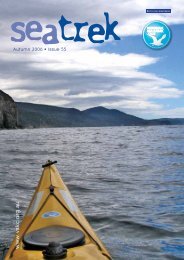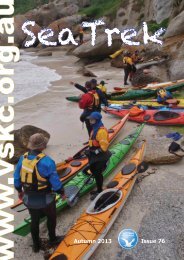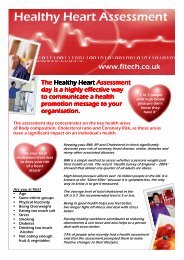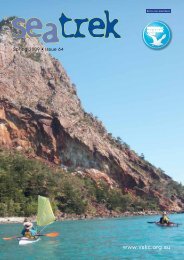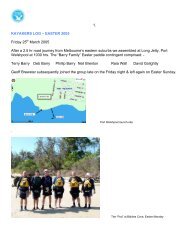Sea Trek Issue 70 - Victorian Sea Kayak Club
Sea Trek Issue 70 - Victorian Sea Kayak Club
Sea Trek Issue 70 - Victorian Sea Kayak Club
You also want an ePaper? Increase the reach of your titles
YUMPU automatically turns print PDFs into web optimized ePapers that Google loves.
EXPEDITION PLANNING part 3, by Robin Boundy<br />
In <strong>Sea</strong> <strong>Trek</strong> <strong>Issue</strong>s 68 and 69 Robin provided some really helpful advice about expedition planning, addressing, who should participate, rules for<br />
participation, training and planning for expeditions (based on his 2010 Bass Strait crossing).<br />
GEAR AND EQUIPMENT<br />
It always amazes me on how much gear<br />
we take on an expedition. It starts with a<br />
list and by the time you’re finished, it<br />
takes up a whole A4 on both sides! Yet<br />
somehow it all fits in your kayak!<br />
The first group of items are for getting<br />
from A to B and should be accessible<br />
from your cockpit!<br />
��<strong>Kayak</strong>, Paddle and leash<br />
��Spare paddle and Spray skirt<br />
��PFD / Life Jacket and Cag<br />
��Gloves, Thermals, Hats / helmet<br />
��Sun Glasses and Booties<br />
��Water bottle or bladder<br />
��Phone with emergency #’s in an<br />
aqua pack and GPS in an aqua pack<br />
��Strobe, Epirb, Signal mirror<br />
��Whistle<br />
��15 m tow rope and 1m tow rope<br />
��First aid kit / medication<br />
��First aid book if not first aid savvy<br />
��Sun screen and Flares<br />
��Repair Kit<br />
��Poncho and Safety blanket<br />
��HF Radio<br />
��Hand pump<br />
��<strong>Sea</strong> anchor and Knife<br />
��Spot tracking device<br />
��Satellite phone and Cameras<br />
��Charts and tide tables<br />
��Head lamp / Torch and Watch<br />
��Bungee cord with olive cleat<br />
��Paddle float<br />
And then you have your land gear. All<br />
items should ideally be packed into dry<br />
bags or doubled up in garbage bags unless<br />
unaffected by moisture. And of<br />
course for some of the items listed, you<br />
may need a sub list!<br />
For example your first aid kit will need<br />
its own list of contents, the repair kit will<br />
need its own list of contents and you may<br />
very well have a list for your land and<br />
paddling apparel.<br />
��Cockpit cover<br />
��Tent and Tarp<br />
��Sleeping bag and liner<br />
��Pillow and Towel<br />
��Head lamp<br />
��Land clothes and Boots<br />
��Rain gear<br />
��Extra paddling gear / thermals<br />
��Trangia and methylated spirits and<br />
Utensils<br />
��Bowl / Plate or both<br />
��Cup or mug and Wash cloth<br />
��Wilderness soap / Dettol / Baby<br />
wipes<br />
��Deodorant and Lanolin for abrasions<br />
��Toilet paper and Trowel<br />
��Rubbish bags<br />
��Matches, lighter or flint<br />
��Fishing line and Spare batteries<br />
��Fly net<br />
��Battery chargers, solar panel<br />
��Short wave radio<br />
��Hand held compass<br />
��Pen, pencil and note book<br />
��Money, credit cards<br />
FOOD AND CONSUMABLES<br />
Just when you thought you had enough<br />
lists, you have your food lists and on an<br />
extended expedition, the simpler the<br />
better. I had a breakfast list, lunch list,<br />
dinner list and an on water food list as<br />
many lunches will be on the ocean.<br />
On an extended expedition, you want<br />
food high in energy but not too bulky or<br />
heavy to carry.<br />
��My breakfast list was easy. Porridge,<br />
brown sugar and milk powder<br />
plus some dry fruit muesli for<br />
variety. I also carried a tall plastic<br />
cup with a lid; l simply added the<br />
milk powder and water, put on the<br />
lid, gave it a good shake for smooth<br />
great tasting milk.<br />
��Lunches most days may be on the<br />
water unless your expedition is following<br />
land with many stopping<br />
opportunities or islands very close<br />
together. When lunch is required on<br />
the water, it may need to be prepared<br />
before departure each day.<br />
Again simple is best. I tended to<br />
stick with Vita wheat crackers, sao<br />
biscuits with kraft cheese, vegemite,<br />
peanut butter and salami. I also<br />
included a pun net of roma tomatoes.<br />
The Romas can take a<br />
beating in the day hatch and last for<br />
days. The taste and spurt of moisture<br />
from one Roma whilst at sea is<br />
very refreshing. I also carried sachets<br />
of tuna and salmon.<br />
��I always carried nuts, scroggin mix<br />
and jelly beans for added energy<br />
when needed or if conditions were<br />
too rough and uncomfortable to<br />
stop paddling to eat.<br />
On our trip, we agreed to stop briefly on<br />
the hour to drink some water and eat<br />
some nuts or other quick snack. The aim<br />
is to not allow your energy levels to get<br />
so low that you feel fatigued or risk dehydration.<br />
You can’t go past dehydrated<br />
food for multi day expeditions and if you<br />
are prepared to do a little research, you<br />
will realize how quickly you can produce<br />
30 days of great tasting meals at a very<br />
reasonable cost.<br />
I also like to add the odd dinner of fresh<br />
fish or abalone for a break from dehi<br />
food. But remember that certain areas<br />
may be a marine reserve where fishing is<br />
illegal. You need to make yourself aware<br />
of these areas as part of your trip planning.<br />
Much of the area around Erith Island,<br />
Tasmania is a reserve, however,<br />
you can fish around most of Deal Island<br />
but not in Murray Passage.<br />
Most of the campsites we selected were<br />
known to be relatively sheltered in most<br />
conditions and some of them had a water<br />
source available to us. By far the heaviest<br />
item carried apart from yourself is the<br />
water you need and at 1 kg per litre, the<br />
weight quickly adds up. I generally carried<br />
17 litres of water, a 6 litre bladder, 2<br />
x 4 litre bladders, 2 to 3 litres in my PFD<br />
bladder and my drink bottle.<br />
As with most things, food and consumables<br />
taken on an extended expedition can<br />
be wide and varied with some paddlers<br />
being quite creative.<br />
As well as your primary dietary needs,<br />
there always seems to be some space<br />
available for some luxury items such as a<br />
litre of red wine, port or other favorite<br />
campsite drink, pre-dinner snacks and the<br />
odd sweet desert.<br />
Next issue, Robin continues with directions<br />
regarding Navigation (Ed)<br />
19



